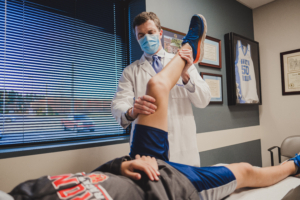Don’t Run the Risk: Best Practices for Sports

It’s finally Spring! And for many people in our community, it means more outdoor physical activity. The bike and running trails fill-up again as the weather warms. Kids recreational sports change over from basketball to soccer and baseball, and USTA tennis championship matches are on at the Rome Tennis Center. But no matter which endurance activity has you moving more, keep in mind that the sports medicine advice you received in preschool might not be up-to-date. Want to test your knowledge? Before you head out on a run, take our quick true/false quiz:
TRUE OR FALSE? STRETCHING BEFORE EXERCISE WILL PREVENT INJURY
FALSE! If you ever took PE as a kid, you were probably asked to stretch before you ran laps. Maybe you also had coaches who believed stretching prevents injury. But this type of stretching, called “static stretching,” is a habit to ditch before your workouts. A 2004 study covering years of stretching research suggests stretching before a workout could increase risk of injury and reduce performance. If stretching makes you feel great, wait until after you workout to try to touch those toes. And if you’re looking for the right way to get warmed up, consider learning more about dynamic warm-ups.

TRUE OR FALSE? CARB LOADING WILL IMPROVE EXERCISE PERFORMANCE
If you are a fan of The Office, it’s hard not to get Michael Scott’s horrible bout with Alfredo out of your mind when you think of carb loading and racing. But in fact, it’s TRUE, carb loading can improve performance if it’s done appropriately. Carb loading should begin at least 48 hours before an endurance event that lasts at least 90 minutes. And it does not mean that you should eat as much pasta as you possibly can. Instead, athletes should carefully plan a diet that adds carbohydrates to each meal to store more “energy” or glycogen in the muscles to draw on during their sports events or workout.
TRUE OR FALSE? NO PAIN, NO GAIN
This one is tricky. Ultimately, the answer is FALSE. Severe pain is a neural indicator that something is wrong. But recognizing this pain requires athletes to get to know their bodies and the difference between training discomfort and acute, sharp pain. The last leg of a marathon or the final quarter when exhaustion kicks in is a very different discomfort than a severe knee pain or chest pain. So, for example, if you are feeling pain in your leg, ask yourself some questions. Where does it hurt exactly? Is this soreness or discomfort from training? Or is this tendonitis? If you are experiencing a serious injury, there is nothing brave about “playing through the pain.”
Are you surprised by any of these answers? Want to know more about sports medicine injuries? Get to know a Harbin sports medicine specialist today!


